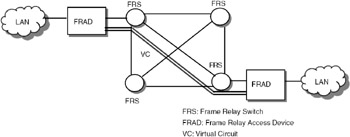28.2 FRAME RELAY NETWORK
|
| < Day Day Up > |
|
28.2 FRAME RELAY NETWORK
The architecture of a Frame Relay network is shown in Figure 28.1. The network consists of a number of Frame Relay switches. Subscriber equipment is connected to the Frame Relay switch through a Frame Relay access device (FRAD). PCs, servers, and such can be connected to the FRAD. Bridges and routers can be provided with Frame Relay interfaces so that they can be connected to the Frame Relay switch.

Figure 28.1: Frame Relay network.
A Frame Relay network consists of a number of Frame Relay switches. The subscriber equipment is connected to the switches through a Frame Relay access device (FRAD).
Frame Relay provides a connection-oriented service, just like X.25. When two end systems want to exchange data, a virtual connection (VC) is established between the two end points, and data transfer takes place.
A virtual connection is of two types:
-
Permanent virtual connection (PVC)
-
Switched virtual connection (SVC)
Permanent virtual connection (PVC): The Frame Relay operator provides the PVC between two end points. This is done by programming the Frame Relay switches in the network to assign a series of links between the switches to form the PVC between the two end points. The PVC is permanently available to the two parties at both ends.
Frame Relay provides a connection-oriented service. A virtual connection is established between two end systems. The virtual connection can be switched or permanent, called SVC and PVC, respectively.
Switched virtual connection (SVC): When the connection is established on a call-by-call basis, it is called a switched virtual connection. SVC requires some overhead for call establishment and disconnection. When Frame Relay was first developed, only PVC was supported, but SVC was added later to meet user requirements.
In Figure 28.1, if an organization has two offices in two cities separated by a large distance, the organization can take a PVC from the Frame Relay service provider if the traffic is high. If the traffic is low, the organization may opt for a SVC and pay only on the basis of use.
A Frame Relay virtual connection is identified by a number called a data link connection identifier (DLCI). Each link can support multiple connections.
The data transfer involves:
-
Establishing a logical connection between end points and assigning a DLCI.
-
Exchanging data frames with each frame containing the assigned DLCI.
-
Releasing the logical connection.
A virtual connection is identified by a number called data link connection identifier (DLCI). The procedure for communication between two systems is to establish a logical connection, exchange data frames, and release the connection.
To establish a logical connection, messages are exchanged over a dedicated logical connection for which DLCI = 0. Four messages, SETUP, CONNECT, RELEASE, and RELEASE COMPLETE, are exchanged to set up and disconnect a logical connection. In the case of PVC, this procedure is not required.
|
| < Day Day Up > |
|
EAN: 2147483647
Pages: 313